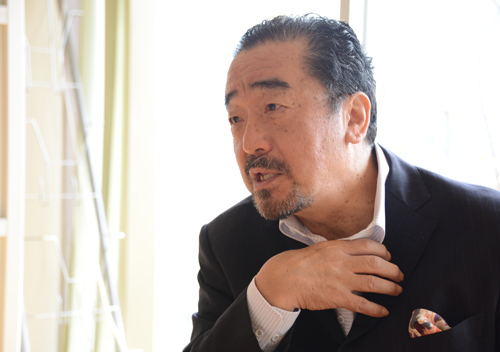
from Thailand vol. 69 2015.02.09 Creating a resilient society - BeGood Cafe's Challenge
![]()
- In the era of global environmental crisis - "Unpredictability" is the new norm
- Off to Asia - in search for "resilience"
- OpenStreetMap and resilience
- IT x resilience is interesting
- From a developing country that faces problems to a developing country that has solved problems
- People who are open to change can survive
"Resilience" is a post sustainability concept that is drawing much attention in Europe as well as in other regions including Thailand, where the "VISIONS Asia Resilience Forum 2014" was organized in September 2014 by Thai's Chulalongkorn University and the Japanese NPO BeGood Cafe. In recent years, humanity has faced numerous natural disasters of unparalleled magnitude. That is why building a "resilient society" - a society that can minimize the impact of natural disasters and get right back on its feet - is going to be increasingly important to all regions around the world. We asked Jun Shikita of NPO BeGood Cafe, who organized VISIONS Asia Resilience Forum 2014 in Thailand, what "resilience" really means.
(Text by Miwako Sasao)
目次へ移動 In the era of global environmental crisis - "Unpredictability" is the new norm
Many of you may be taken aback by the climatic abnormalities of late. Without doubt, the frequency and impact of natural disasters have risen at an alarming rate. Take the tornado that hit Koshigaya City, Saitama Prefecture (September 2013), the mudslides in Izu-Oshima caused by Typhoon 26 (October 2013), and the landslides in Hiroshima (August 2014) for example. In Japan, we have become quite accustomed to torrential rains and typhoons that they no longer faze us. And in September 2014, Japan also experienced the volcanic eruption of Mount Ontake. Who could have predicted such an event? When I saw on TV photographs of smiling climbers who had made it to the peak, I realized that natural disasters could affect any one of us at any time. We are all vulnerable to natural disasters, but is there something we could be doing to better prepare ourselves?
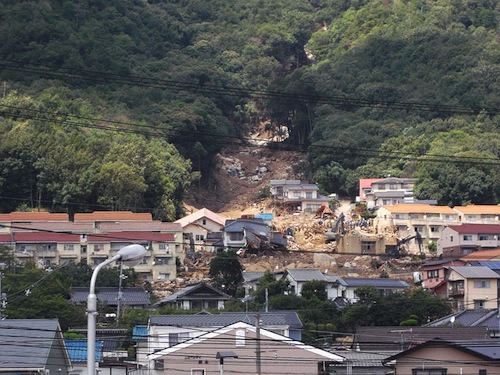 Landslides in Hiroshima in 2014 (Photo By Taisyo (Own work) [GFDL or CC-BY-3.0], via Wikimedia Commons)
Landslides in Hiroshima in 2014 (Photo By Taisyo (Own work) [GFDL or CC-BY-3.0], via Wikimedia Commons)
To prevent global warming, we have, until now, generally been trying to mitigate the situation by reducing greenhouse gas emissions. But as we face more frequent climatic abnormalities, the world has begun to discuss the need for measures that help us better adapt. This was also a topic of discussion at the IPCC (Intergovernmental Panel on Climate Change) held in Yokohama in March 2014.As we shift from risk mitigation to risk management, the concept of "resilience" has begun to draw attention globally.
At the "VISIONS Asia Resilience Forum 2014," which was held in Bangkok, Thailand for 3 days in September 2014, experts across Asia from various fields came together to discuss disaster prevention, risk mitigation, revitalization of marginal villages, and resilience.
It was Mr. Jun Shikita of NPO BeGood Cafe who organized this forum. Mr. Shikita established the NPO BeGood Cafe in 1990, and since then he has planned and organized events on "sustainable societies and peace" at Earth Day Tokyo and at the Eco-Products Exhibition. And every year since 2006, BeGood Cafe has also organized the Ecovillage Conference at which participants from around the world including countries such as Denmark and UK who live sustainably get together to discuss how people in Japan can create an ecovillage, a sustainable community in Japan.
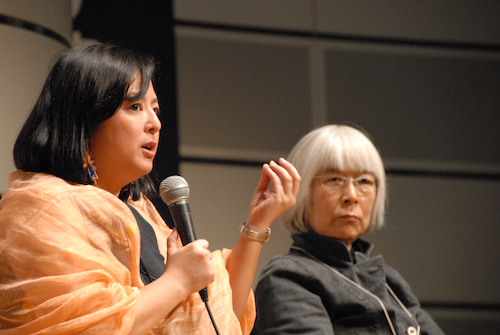 Penny Velasco shared stories about ecovillage activities in the Philippines at the Ecovillage Conference Tokyo 2007 (photographs provided by: NPO BeGood Cafe)
Penny Velasco shared stories about ecovillage activities in the Philippines at the Ecovillage Conference Tokyo 2007 (photographs provided by: NPO BeGood Cafe)
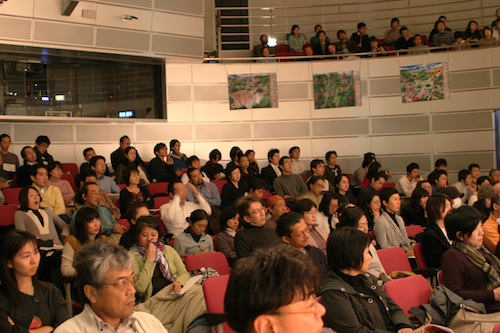 Photographs from the Ecovillage Conference Tokyo 2007 (photographs provided by: NPO BeGood Cafe)
Photographs from the Ecovillage Conference Tokyo 2007 (photographs provided by: NPO BeGood Cafe)
But since the Great East Japan Earthquake of March 11, 2011, he began to think bigger, not only about the sustainability of communities, but also of the whole nation. Feeling that people in Japan had become somewhat lethargic, Mr. Shikita wanted to reawaken the nation with new ideas and business possibilities. That is why he created a new platform for discussion that he has named "VISIONS."
"For the first 3 years, I invited Japanese people (heroes) who were helping to revitalize marginal villages and regions with unique ideas. We wanted the audience to learn the how-tos from these heroes and test these ideas in their own communities. I was hoping that Japan as a whole would become revitalized if we could help create more success stories in more regions. That was when I became intrigue with the keyword, resilience."
How can marginal villages survive? And how can we create strong communities that can withstand or recover from natural disasters. "Resilience" perfectly embodies Mr. Shikita's desire to revitalize communities and to take preventive measures against natural disasters.
目次へ移動 Off to Asia - in search for "resilience"
Resilience means to be able to bounce back, to recover, or to stand back up. The word takes on a slightly different meaning depending on the context in which it is used. For example, bamboos bend with the wind and spring back up when winds die down. The environmental journalist, Ms. Junko Edahiro believes resilience means to be like bamboos, to be "strong, but also pliant, supple, flexible." And Mr. Shikita believes that resilience means to 「"keep one's chin up and to live life with vigor and zest."
Originally, the term "resilience" was used in the field of ecology, but nowadays it is being used in multitudes of fields including psychology, civil engineering, and economy. For example, Nikkei Woman published an article on "How to hone 'resilience' - the ability to bounce back from any adversity" (October 2014). And the term has also begun to be used in the business world to refer to a businessman's ability to manage risks and self, to individuals that have the ability to overcome difficult situations.
And in Europe, interest in "resilience" as a keyword for sustainability has been growing. Sustainability is a static concept that focuses on finding a theoretical equilibrium. But nature is ever changing. Since resilience is more dynamic, it is better suited to nature and can offer more realistic measures.
It is important to be prepared for unforeseeable events, but when disasters strike, we should not simply reply on existent systems and reserves. Individuals and communities should work together to find ways that make sense for them, to bounce back from the calamity.This is what is meant by a "resilient society."
When thinking about how we can become resilient against global issues such as climate change and recovery from disasters, it is important to think beyond national borders. VISIONS Asia Resilience Forum 2014 was held in Thailand, and Mr. Shikita wishes to organize the next forum in Indonesia. So he is already thinking about the future of Japan from a global perspective.
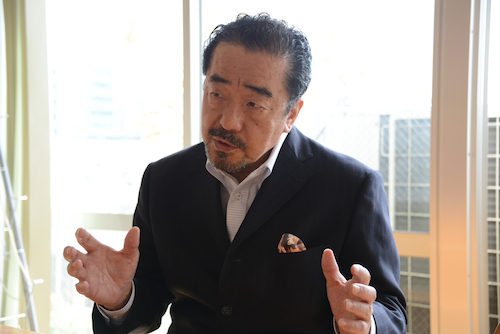 Mr. Jun Shikita from the NPO BeGood Cafe. "First concentrate on Asia, then the rest of the world." He spoke about the importance of establishing a global network.
Mr. Jun Shikita from the NPO BeGood Cafe. "First concentrate on Asia, then the rest of the world." He spoke about the importance of establishing a global network.
"20 years ago, it was ok to only think about issues in terms of Japan. But nowadays there are many key players around the world, so it has become increasingly important to travel abroad, to many places around the world so that we can establish rapport with these key players. We will first start in Asia, and then go beyond, but we hope to have a global perspective whatever the case may be."
You may remember the massive floods of 2011 that devastated the Chao Phraya river basin in northern Bangkok, Thailand. According to the World Bank, the severe flooding that struck Thailand was the world's fourth costliest disaster after the Great East Japan Earthquake, the Great Hanshin-Awaji Earthquake, and Hurricane Katrina. Having experienced this calamity, Thailand, like Japan, has become very aware of the impending danger. Moreover, Chulalongkorn University has been conducting research on resilience. That is why Mr. Shikita decided to organize the VISIONS Asia Resilience Forum 2014 in Thailand.
Day 1 of the forum featured an academic discussion on resilience. Professor Makoto Taniguchi of Japan's Research Institute for Humanity and Nature gave a keynote speech.
"Demand for key resources like water, food, and energy will continue to grow in the future as population increases and our lifestyles change. And there are so many issues we need to address such as biodiversity conservation, measures against disasters, and reducing carbon dioxide emissions in cities."
Researchers discussed issues their own countries are facing. For example, the birthrate in Thailand is continuing to decline, and India had just experienced a devastating flood in September 2014. Natural disasters have indeed taken many lives. Participants reiterated the need to be better prepared by going beyond academia, by encouraging knowledge sharing among experts from a wide range of fields, from NGOs and NPOs working on regional projects to community leaders.
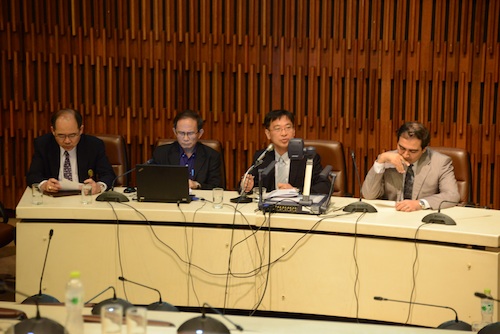 Day 1. From the left: Dr. Vithaya Kulsomboon of the Chulalongkorn University, Dr. Surichai Wun'gaeo of RECNA, Professor Makoto Taniguchi of the Research Institute for Humanity and Nature, and Dr. Bharat Dahiya from the University of Cambridge.
Day 1. From the left: Dr. Vithaya Kulsomboon of the Chulalongkorn University, Dr. Surichai Wun'gaeo of RECNA, Professor Makoto Taniguchi of the Research Institute for Humanity and Nature, and Dr. Bharat Dahiya from the University of Cambridge.
Speakers on day 2, included activists who have taken a community-based approach to help people overcome natural disasters, who have helped revitalized marginal villages, and numerous case examples of application of IT technology.
Mr. Jun, Chairperson of the NGO Salon de AManTo in Nakazaki-cho, Osaka, who is helping to develop community ties from his cafe and Mr. Kazuo Nishiguchi, Chairperson of the incorporated NPO Ueyama-tanadadan in Okayama Prefecture, who has helped revitalized terraced rice paddies in deserted arable land shared the results of their activities. And Mr. Taichi Furuhashi the Chairperson of Race for Resilience, who runs the "Developing Countries x Disaster Prevention, Mitigation" hackathon introduced the application developed at the hackathon organized in 2014. And the last panel discussion featured speakers from various countries, who discussed how we can all join hands to help bring about a resilient society.
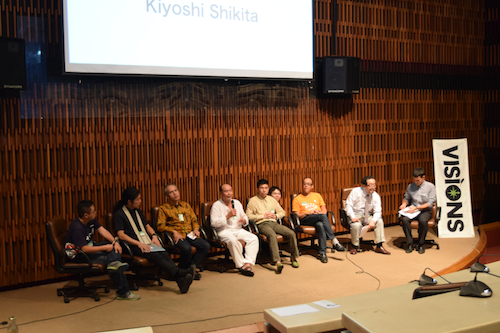 Day 2. Audience joined the discussions on how we can create a network in Asia.
Day 2. Audience joined the discussions on how we can create a network in Asia.
目次へ移動
Open street map and resilience
On Day 3, the forum moved to Pathumthani, located 1 hour away from Bangkok, for a mapping excursion. Mr. Taichi Furuhashi, the Vice Chairperson of OpenStreetMap Foundation Japan served as the moderator for that day. To prevent flooding, villages dot the coastline of the 22km canal. After the group inspected these villages, Mr. Furuhashi asked them, "So, do you know where you are right now?"
The map they were given on the bus was divided into 4 areas, and there were no distinguishing landmarks. And for most people, it was unfamiliar terrain, so the participants realized that it was very difficult to figure out where they were.
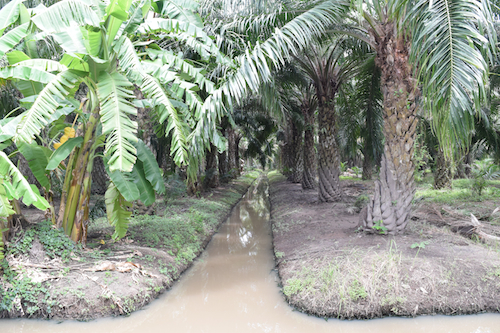 The intricate network of meandering canals in Pathumthani.
The intricate network of meandering canals in Pathumthani.
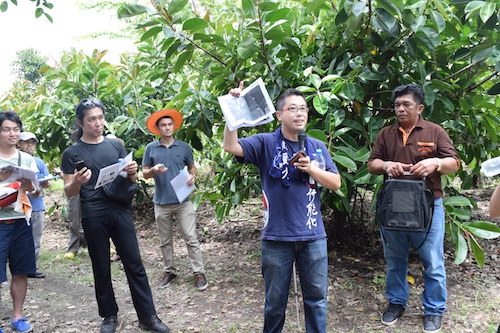 Mr. Taichi Furuhashi explained how mapping works to the workshops participants.
Mr. Taichi Furuhashi explained how mapping works to the workshops participants.
Participants with pen and paper scribbled information about buildings, utility poles, and roads onto the map. Information obtained on site was then inputted into the "OpenStreetMap." OpenStreetMap is a free editable map that anyone can easily view and edit via PCs or smartphones as long as there is an Internet connection. You can also instantly share a map that you have created with people all over the world. Since its launch in the UK in 2004, the number of OpenStreetMap users has continued to climb, and now the service boasts 180,000 users (as of October 2014).
Maps of the community are very important to disaster prevention. Accurate information about the region is essential in times of disaster for surveying and mitigating the damage. Actually, when the Great East Japan Earthquake struck, many people shared information using the OpenStreetMap.
After participants had a go at mapping, Mr. Furuhashi conducted a mapping demonstration. Using innovative IT technology such as the GigaPan, which can shoot 360-degree panoramic images, and unmanned drones it is now possible to obtain even more accurate spatial information. When you hold a drone, you will be surprised at just how light they really are. And they are really simple to build. The participants cried out in amazement when the compact body equipped with a camera took flight. The program on the third day was quite different from the first 2 days, but what was the purpose?
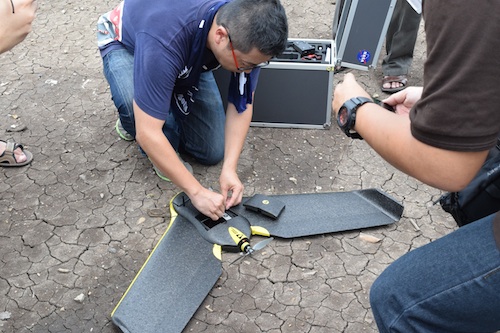 Attaching a small camera to the unmanned drone. The flight distance was pre-programmed. Thirty minutes later it return to the place from which it took off.
Attaching a small camera to the unmanned drone. The flight distance was pre-programmed. Thirty minutes later it return to the place from which it took off.
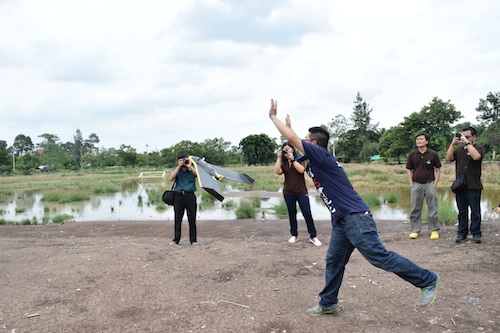 The drone about to take off. It helps provide more accurate spatial information using GPS data and aerial footage.
The drone about to take off. It helps provide more accurate spatial information using GPS data and aerial footage.
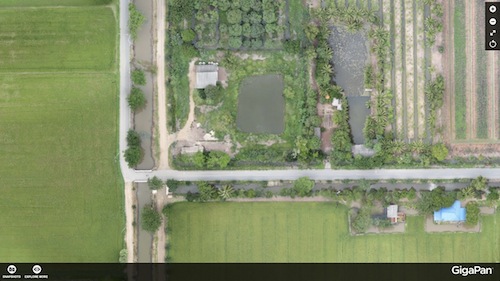 Aerial footage taken by the drone (photograph provided by: Mr. Taichi Furuhashi).
Aerial footage taken by the drone (photograph provided by: Mr. Taichi Furuhashi).
As these mapping technologies continue to advance, they will become more and more useful in times of disaster, such as fires and floods for surveying inaccessible areas. Moreover, if maps are old, you may find that the route by which you were counting on making your escape in case of an emergency may no longer be there, so it could be the difference between life and death. OpenStreetMap, which allows any user to update and edit maps in real-time, is a tool that can truly help contribute to resilience.
目次へ移動 IT x resilience is interesting
Mr. Shikita met Mr. Furuhashi and programmers and engineers at the "Race for Resilience," a "Developing Countries x Disaster Prevention, Mitigation" hackathon held in February 2014. That is where his interest in IT x resilience began to develop.
"Resilience has multiple meanings and also involves different groups of people - people who study it academically, people who are putting it into practice. So where do we stand? We have been working to revitalize marginal villages, so in that respect, we wanted to focus on what we could do with IT to help these communities in case natural disasters strike."
Hackers can create apps, but in the past, they have not been able to visit afflicted areas to brush up the apps they have developed. The workshop on the third day was organized to help bring together local needs and hacking technology. It is very difficult to bridge the gap between app users and developers, but these efforts will help create apps that will be useful when disaster strikes.
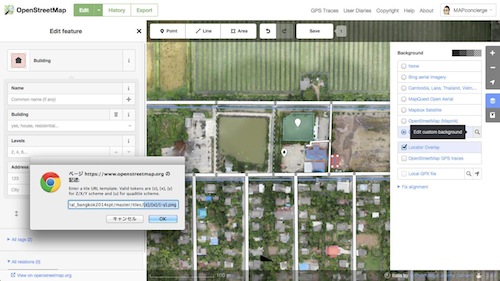 New information was inputted and a new road was added to the OpenStreetMap. Updated information can be instantly shared with people across the world (photograph provided by Mr. Taichi Furuhashi).
New information was inputted and a new road was added to the OpenStreetMap. Updated information can be instantly shared with people across the world (photograph provided by Mr. Taichi Furuhashi).
"For example, even if we worked very hard in afflicted areas, we wouldn't have as much impact as professional NGOs like Peace Boat. And even if we tried to find academic answers we're not properly equipped to do so. Our job, after all, is to bring people together, to create a framework that allows for governments and universities to work together. That is what we need to focus on. In that respect, we are thinking of ways to bring together people all across Asia. But the theme we're working on is so massive, we need to join hands with people from a wide range of fields."
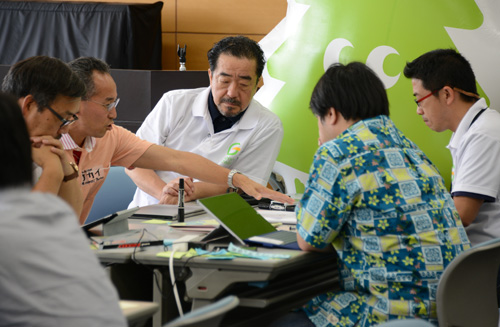 In July 2014, Mr. Jun Shikita organized the Green Hackathon Fukushima, a hackathon about renewable energy and disaster prevention.
In July 2014, Mr. Jun Shikita organized the Green Hackathon Fukushima, a hackathon about renewable energy and disaster prevention.
目次へ移動 From a developing country that faces problems to a developing country that has solved problems
The population in Japan is decreasing and graying. Falling birthrates, an aging population, national pension issues, decline of rural areas, population growth in cities, and energy issues - Japan is a developed country that faces countless issues. But this also means that we have an opportunity to become a developing country that has solved these problems. Other countries will face similar problems down the line, so Mr. Shikita believes that Japan has a unique opportunity to lead the way.
"Are you familiar with the 'Machi Hito Shigoto Souseihonbu (Town-People-Work Initiative)'? This new initiative was launched in 2014 by the Abe administration to help revitalize rural regions. Mr. Shikita, who has been committed to helping solve issues marginal settlements are facing and reviving rural regions from long ago thought, "Finally, the wind has started to blow our way!" and that this will become the most important trend for the next couple of years.
"Since August 2013, I have been supporting the 'Zenkoku Suigennosato Renraku Kyougikai (National Rural Village Water Resources Association).' 170 chiefs from marginal villages across Japan are members of this association. At first, I wasn't sure how I could help this association. Then the former Minister of Internal Affairs and Communications, Mr. Hiroya Masuda issued a shocking report projecting that 896 cities, towns, and villages will disappear by 2040. This report has sounded an alarm. So I started working with Mr. Zenya Yamazaki, the mayor of Ayabe City and Chairman of the aforementioned association, on a project to bring together members of this association and leaders of the 896 cities, towns, and villages projected to disappear. This will bring the total number of leaders to more than 1,000. We want them all to join hands, to work together to make sure that 'We don't disappear!' If we can do this, this will help create quite a significant movement. To make this possible, we are thinking of organizing workshops for these leaders. It's imperative that leaders take part, not their substitutes such as assistant managers of the administrative division. We want to share successful case studies undertaken by heroes with these leaders to show them all the different possibilities. This is something only we are capable of doing."
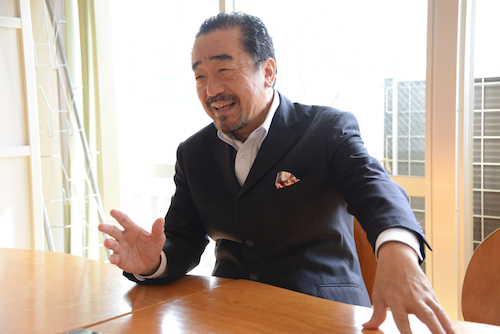 Mr. Jun Shikita believes that the "issues" Japan faces are actually opportunities.
Mr. Jun Shikita believes that the "issues" Japan faces are actually opportunities.
目次へ移動 People who are open to change can survive
"It is not the strongest or the most intelligent who will survive but those who can best manage change." This is a famous quote from Charles Darwin's Theory of Evolution. I believe that these words accurately express the necessity for resilience.
"We're working on a few things leading up to the United Nations World Conference on Disaster Risk Reduction, which will begin in Sendai City on March 14, 2015. One is a session where we will invite participants from around the world to share case studies on resilience. Another is a hackathon that can show people how IT can be used to help prevent disasters. We're hoping that NGOs from regions that are frequently struck by natural disasters like the Philippines and Indonesia will also take part so that they can directly communicate their experiences and needs with Japanese engineers. We haven't decided yet, but we are tentatively thinking of giving it a fun name like Asia Resilience Fes."
Now is the time to seriously think about how we can survive in this ever-changing environment. Environmental issues are no longer problems for the coming generation. They are our problems that we need to address today. But no matter how hard we try to explain this with words, words won't be enough. People who have come to realize this need to lead the way for the rest of the world by taking action. Mr. Shikita travels the world to meet new people, carve out new paths, and he is not afraid of failure. His perseverance and commitment to address issues will be a great example for us all, as we set out to build a resilient society. Mr. Shikita continues to move forward without stopping, and I hope to continue to cheer him on and to support him.
参考サイト:
NPO BeGood Cafe(http://begoodcafe.com)
VISIONS ASIA(http://visions.asia)
OpenStreenMap(http://www.openstreetmap.org)
Report, text, and photographs by: Miwako Sasao (Think the Earth)
Edited by: Soichi Ueda (Think the Earth)
Translated by: Yuri Morikawa (oxygen inc.)















